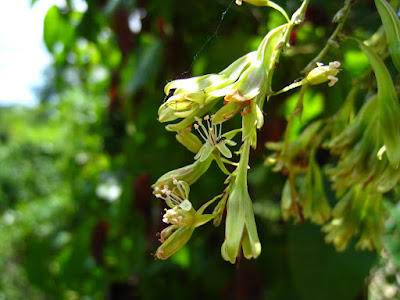Here is
Pueraria montana of the family
Fabaceae:
This particular flower was photographed August 28, 2011 in Opelika, Alabama. There are a number of species in the genus
Pueraria but these are closely related and most not readily distinguished from one another. These species all answer to the name kudzu. As most who've been in the southeast will know, is everywhere, it was introduced from Asia as a means to control erosion and it grows like wildfire, enveloping everything.
As it is a member of the pea family,
Pueraria spp. produces pods, hairy ones. These dangle below the stem that supports the cluster of flowers, growing ever longer, pictured below:
Despite the pestilent nature of this plant, the blooms are beautiful and have a sweet, subtle smell similar to honey suckle, the root is rich in starch and serves as an excellent grazing plant for 3 or 4 years. There may even be medicinal properties hiding in the plant, however, most folks just want to know how to get rid of it. Wikipedia offers quite a number of ways to control the plant, the
worst being devised by a sixteen year old Jacob Schindler, which involves disgorging
precious helium into the ground.
I know this is a post about plants, but most folks don't realize that helium is a precious and limited resource. The
New York Times reported in 1997 on the dismantling of the Federal Helium reserves sounding the warnings for the physics community but haven't written anything since. The most recent news is from Cleveland,
sounding the warning bells a little over a month ago: we're running out.

















































